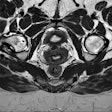
VIENNA - Some prosthetic devices that pass as MR-compatible for patients may not be safe for radiographers and nurses, according to a presentation at Thursday's scientific session dedicated to safety in MRI.
Dr. Nadia Oberhofer, from the medical physics department at Bolzano Hospital in South Tyrol, Italy, came to this conclusion after an investigation was triggered by the case of a nurse in the anesthetics department who experienced pain in her ear while rushing toward a patient in need of help within the MRI system. Her pain persisted for a week. A month before the incident, the nurse had had a stapes prosthesis implant.
 Manufacturers should provide a risk assessment for workers as well as patients regarding nonferromagnetic implants, according to Dr. Nadia Oberhofer from South Tyrol, Italy. Image courtesy of the European Society of Radiology.
Manufacturers should provide a risk assessment for workers as well as patients regarding nonferromagnetic implants, according to Dr. Nadia Oberhofer from South Tyrol, Italy. Image courtesy of the European Society of Radiology.
"As the nurse rushed forward and placed her head inside the bore, she experienced pain, which she described as similar to a rubber band going 'ping,' " Oberhofer reported to a fascinated audience.
The otologic prosthesis was a SMart stapes piston made from fluoroplastic plus nitinol, which is a nonferromagnetic, nickel-titanium alloy. This alloy has a magnetic susceptibility considered to be less than pure titanium.
The case highlights the question of whether additional safety information was needed for staff. The nurse had been told that her implant was safe by the lead physician, so she had not requested an additional safety assessment. For non-MR personnel, Bolzano Hospital currently carries out an annual safety check.
Curious as to why the nurse experienced such pain, and what medical physicists could do in such a situation, Oberhofer examined the literature and appropriate websites. The results were mixed. She found that www.mrisafety.com listed the device as safe, and a paper examining titanium middle ear implants in a 3-tesla MR unit also considered them to be safe, with respect to the patient. There was no mention of prostheses in staff.
She also noted that another search revealed some implantable otologic devices were only safe under certain circumstances, as specified by the manufacturer. Her search revealed that Olympus states that nitinol SMart stapes piston technology implants are safe in machines of up to 3 tesla.
Oberhofer showed a recording of a film demonstrating what happens when a prosthetic device moves slowly through a magnetic bore at a rate of 2 cm/sec; it turns through 70°, and then returns to its original position as it slowly exits the bore.
"But if a nonferromagnetic metal device enters the bore quickly, at a rate of around 100 cm/sec, then it flips around quickly," she explained. "It is subject to Lenz's law, which says any metallic object which experiences a difference in magnetic flux dFB is subjected to an opponent force."
Effectively, devices in the patient are associated with a slow introduction into the bore, but workers have different conditions often showing vertical movement and even rotational movment of the head.
Oberhofer thinks manufacturers should provide a risk assessment for workers as well as patients regarding nonferromagnetic implants. "Even if scanning with these devices is permitted for the patients, personnel might not be permitted to enter the MR examination room near the gantry," she said.
Session moderator Oliver Speck, PhD, from the University of Magdeburg in Germany, pointed out that the presentation was related to the Electromagnetic Field (EMF) Directive, which is dsigned to protect workers from electromagnetic fields.
"Personnel were not operating under the same circumstances as patients, and radiologists must instruct their staff to this end. People need to stay calm as in any emergency situation and this might be the solution," he said.
Originally published in ECR Today on 8 March 2013.Copyright © 2013 European Society of Radiology



















